| Reviews & Columns |
|
Reviews DVD TV on DVD Blu-ray 4K UHD International DVDs In Theaters Reviews by Studio Video Games Features Collector Series DVDs Easter Egg Database Interviews DVD Talk Radio Feature Articles Columns Anime Talk DVD Savant Horror DVDs The M.O.D. Squad Art House HD Talk Silent DVD
|
DVD Talk Forum |
|
|
| Resources |
|
DVD Price Search Customer Service #'s RCE Info Links |
|
Columns
|
|
|
Bambi: Diamond Edition
THE MOVIE:
Please Note: The screengrabs used here are from the standard-definition DVD included in this set, not from the Blu-Ray.
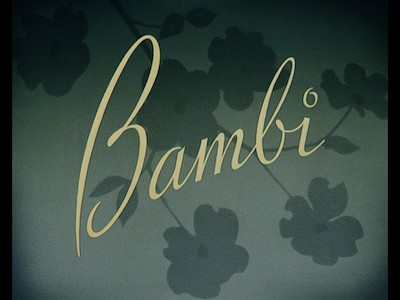
I was a Disney obsessive from a young age. Most of my exposure to the animated movies came from the regular revival system the company had running at the time. All of the classics were in a rotation for being re-released to the theatres, a practice that continued when home video became a new market. Every few years, they'd trot out an old film for another run, which then became the habit of releasing video versions and pulling them off the market shortly thereafter, to wait another few years before sending them out again. It meant the films never got stale or too overexposed, constantly regenerating their audience.
Bambi didn't impress me much as a kid. I thought it was kind of slight and overly sweet. The story didn't seem to have much going for it, and while I found Thumper kind of funny in the way I liked all the obnoxious sidekick characters, there wasn't a big hero in a grand plot that I could lose myself in. When it first came out on DVD in 2005, it wasn't a release I was looking forward to with any great enthusiasm.
Boy, was I ever a dumb kid.
And what a difference even a few more years makes. The announcement of the Blu-Ray had me instantly salivating.
Bambi is a triumph on many levels--artistically, technically, pleasurably. The story is not slim so much as economical, streamlined to perfection. There is no fluff here. Even the comedic sequences are calculated to build on the characters and advance the movement of the overall plot. Essentially, this is the story of a community as it grows over several seasons. We see the birth of a young deer, follow him through childhood to adolescence to adulthood, all in the span of 71 minutes of a movie.
One thing that strikes me as particularly risky for a children's cartoon is there is more silence than dialogue in Bambi. Many sequences are told through music, letting the orchestration punctuate action and inspire the proper feelings. The ingeniousness of the April shower sequence rivals anything in Fantasia, the rhythm of the first raindrops giving way to a full choir as the animals scurry to their homes to get dry. There is even time for comedy here, as a mouse runs from one mushroom to another, each time the canopy growing larger, finally ducking under the tail of a quail as it runs by the little rodent's hut. Several sequences like this give you the breadth of a full season in very short order, how weather affects the world around us, the things we have to do to get by, and the choices we must make to move forward.
Color also plays a key role in the storytelling. Again, choosing the right color scheme can give the animators a shorthand to put a lot of information across in very few frames of film. It allows them to set of mood: the desolation of winter in the expansive white and blues, the orange of the autumn contrasting with the hotter oranges of the forest fire (it's an interesting parallel, a natural cycle of nature vs. an unnatural one), the pink tones of a love-struck spring. It's not just the natural world, either. When Bambi gets in a fight with another stag, the sky comes alive with their passion, becoming imbued with the redness of their anger.
As I've indicated, Bambi is not simply about the growth of a boy into a man, but it has the parallel story of the cycles of nature and its place in the modern world. The forest is not secluded. Man is a foreboding presence, but not necessarily evil--or perhaps more of a necessary evil. When the hunting dogs come, it is an accepted occurrence. Hunting is part of existence. In one of the story notes in the supplemental section on the BD, it is suggested that the idea behind this is that the animals understand and accept this particular aspect of their society, that one form of animal will turn against another. It's like all the woodland creatures have an agreement--you do what you've gotta do, and we'll do what we've gotta do.
The richness of the backgrounds is all the more impressive when you consider the simplicity of them. The animators knew that a real forest was so incredibly detailed, it would be hard for the characters not to get lost in them. So they looked to Asian painting styles to find a balance, to see how a distilled impressionism and a strong reliance on color could make the suggestion of a real nature scene feel as genuine as a photograph. This gave them plenty of room to make their characters all the more real. I couldn't help but marvel at the subtlety of gesture in the key animation. Look again at the scene where Thumper breaks down in laughter when Bambi calls the skunk a flower. Look at how his foot twitches. It's just a quick couple of flicks, but any pet owner has seen it before on their own animals, usually to shake themselves dry when they've stepped in something or to get rid of an itch. What cleverness to take that and make it part of the animal's laughter!
A large part of the accuracy in making the animals appear human is due to the fact that the animators didn't study just the animals they were imitating, but human children, as well, to capture the traits they sought to transfer over. Rather than turn to adult voice actors, Disney got real kids into the studio, and used their mannerisms, their mistakes, and their improvisations to give further life to the studio's fictional creations.
In the character animation, silent gestures speak volumes in the same way an abstract line in the background gives the sense of a larger picture. This is most evident in Bambi's relationship with his parents--the quiet nurturing of his mother, the stoicism of his father (always seen from low angles, his head raised), and the changes in Bambi's body language as he accepts the tragedies fate handed him. Disney was looking to spark his audience's imagination, to inspire the viewers to immerse themselves in the sensations of the movie as much as possible. Just as he used the things unsaid as a doorway to connect with our minds, he also used the things unseen. For instance, we never see a man, only the fear he inspires. We also don't see the famous scene of the death of Bambi's mother, just the loneliness and isolation it creates. One commentator in the "Backstage/making of" section notes that people often seem to remember seeing the mother get shot, even though no such scene exists in the movie. It's all off-screen. That's how vivid a response the story stirs up.
And why a return to the movie is such a compelling experience every few years. I am on the Disney cycle again, catching up with my woodland friends with each new release. It's the kind of reunion that never gets tiresome. Bambi is a renewable energy, never losing vitality or necessity.
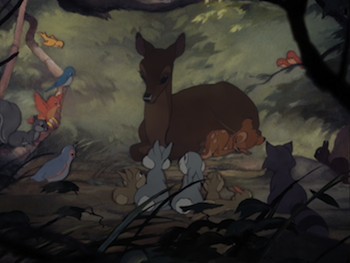
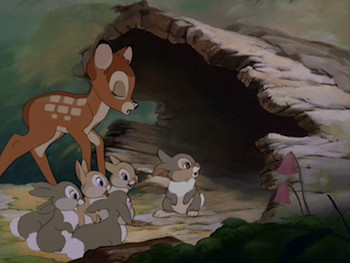
THE DVD
Video:
Holy gee! I can't enthuse enough about how great the Bambi: Diamond Edition looks. The full frame (1.35:1) image is gobsmacking. Colors are vibrant, the animation line art is sharp as a razor. I am speechless. Disney's pioneering multi-plane process goes nearly 3D at 1080p, and the subtle differences in painting technique shows added texture without losing any of its illusory effect. No digital problems occur, no added pixilation or ghosting, and the print is absolutely pristine--no damage, no scratches. It looks like the paint just dried!
Sound:
Soundtrack options in the original English format are a new 7.1 DTS-HD mix or the restored original soundtrack, presented in 2.0. The 7.1 mix does good work without going overboard. You will most notice added oomph in the orchestration, as well as some background work in different scenes, but nothing that destroys the original flavor or is too distracting.
Language options for all subtitles and menus--which you choose at the start of the disc--are English SDH, French, and Spanish. The latter two are also options for dub tracks, with both languages mixed in 5.1.
Extras:
The single Blu-Ray disc for Bambi has a whole bunch of new bonus features, as well as a full "Classic DVD Bonus Features" section porting over all the extras from the previous DVD release, 2005's "Platinum Edition." There is an additional interesting interface in the main menu, where the menu "recommends" a bonus feature. As you finish one, it recommends another. There is also a complete and separate bonus menu for any who want to jump straight to a supplement on their own. Please be aware, too, that there are also some extras on the bonus DVD copy included in this set. I will try to note both.
Other play options include a screen saver for when you are going to leave your disc unattended (5, 10, or 20 minute delays can be chosen) and Disney's "Fast Play" setting, which plays the whole disc front to back.
Up first are newly restored storyboards for deleted scenes: one featuring Bambi tangled up in a reed, another is a charming bit where two leaves who are in love get torn apart by autumn. (Note: These scenes are different than scenes on the "Platinum Edition" DVD, which had two more, now included in the Classic section.) Alongside this is a deleted song, "Twitterpated." The demo for the tune is presented as an audio feature with a title card.
The Disney Big Book of Knowledge section is an interactive set-up for kids, with knowledge-based activities and a goal of collecting all the "stickers" to show you have completed the activity book. Blu-Ray memory technology means kids can save their places from one session to the next. The interface is pretty simple, and there is a good tutorial to get started. Again, these games are different than what was on the old disc; however, the standard-def bonus DVD that comes with the movie has that 2005 Disneypedia feature that teaches kids about animals and such.
An absolutely essential interactive art gallery has five individual sections: character design, backgrounds, production pictures, storyboards, and visual development. This has some cross-over with the galleries on the previous DVD, but the new format is far more multifaceted, with different choices of how to view the art and also ways to mark favorites, rate the images, etc.
The bonus DVD that comes with the movie--which again has the full-length, standard-def version of Bambi--has an introduction by Diane Disney Miller, alongside the ability to watch the Inside Walt's Story Meeting commentary/trivia track. This was my favorite feature from the "Platinum Edition" DVD, and have no fear, it is also on the Blu-Ray. I thought this was an absolutely ingenious innovation on the 2005 disc, adding life to the concept of the audio commentary. Detailed transcripts were made of the many story sessions Walt Disney held with his staff when Bambi was being developed. Key sections of these discussions are re-enacted in order to show the thinking that went into the creation of specific scenes and how those scenes were viewed as part of the overall film. To further open up the creative process, the main picture is often shrunk to make room for storyboards, conceptual art, and photos and archival footage of the animation team at work. I've seen very few contemporary commentaries that gave me as much insight into the crafting of a motion picture as this one. It also speaks to Walt's uncanny sense of storytelling how many of his ideas became components of the final product.
Given that enhanced track is a carry-over from the "Platinum Edition," now is a good time to go over the Classic DVD Bonus Features" section. In addition to the two previously released deleted scenes, there is a crop of great stuff, even by Disney standards, rivaling even my favorite of their DVD packages, Sleeping Beauty. There was nearly an hour on the making of the film, with several of the actual animators, voice actors, and many of Disney's current staff interviewed. Additionally, a 9-minte visit to the studio art archives, a vintage explanation of the pioneering multi-plane camera (from 1957), and the "Silly Symphonies" short "The Old Mill" (from 1937) where that device was first tested out, and the original 1942 theatrical trailer. The only pieces missing are a look at the restoration process, a short history lesson of the year the film was released (1942), and a preview of Bambi II--certainly not essential!
Trailers for contemporary Disney releases also play as the discs load. Duuuude, the Blu-Ray Lion King is going to be amazing.
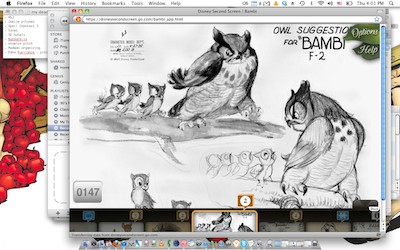
Screengrab of Second Screen on my laptop.
Finally, there is a second enhanced Disney interactive feature, fittingly titled "Disney Second Screen." A short tutorial on the Blu-Ray explains that once you have downloaded an app for it ( http://disneysecondscreen.go.com/bambi/#video), you can activate it while you watch Bambi and there will be more galleries, games, and other interactive features. This should work on your iPad or home computer. At the time of this writing, the iPad app was not yet available, but using the promo rewards code from my BD, I was able to launch the online version. The program uses your computer's microphone to sync with the playback, and it gave me all the features. It started working right away, with the first choice being able to see the opening scene of the movie broken down in its individual multi-plane art levels, complete with text explanations. From there, different trivia, art, and other choices like games and flipbooks, came up. I was skeptical, but I have to admit, this is kind of cool. One note: if you pause the movie, the second screen keeps going, and you will have to choose the option of syncing it up again once you start up another time. You can also break from the playback and explore on your own, moving through the timeline as you see fit.
FINAL THOUGHTS:
DVD Talk Collector Series. If you haven't revisited Bambi yet, don't let this opportunity pass you by. You're in for a rare treat, and once the Disney people do what they do and yank this disc off the shelves, it's hard to say how long you'll have to wait before you get the chance to see it again.
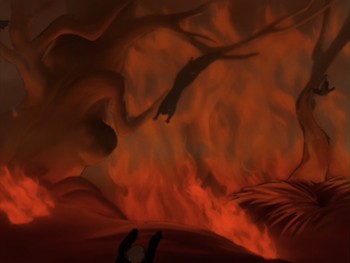
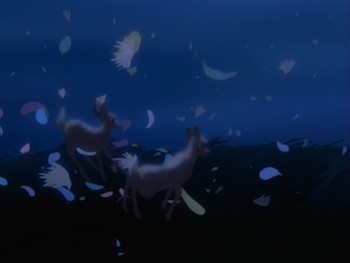
Jamie S. Rich is a novelist and comic book writer. He is best known for his collaborations with Joelle Jones, including the hardboiled crime comic book You Have Killed Me, the challenging romance 12 Reasons Why I Love Her, and the 2007 prose novel Have You Seen the Horizon Lately?, for which Jones did the cover. All three were published by Oni Press. His most recent projects include the futuristic romance A Boy and a Girl with Natalie Nourigat; Archer Coe and the Thousand Natural Shocks, a loopy crime tale drawn by Dan Christensen; and the horror miniseries Madame Frankenstein, a collaboration with Megan Levens. Follow Rich's blog at Confessions123.com.
|
| Popular Reviews |
| Sponsored Links |
|
|
| Sponsored Links |
|
|
| Release List | Reviews | Shop | Newsletter | Forum | DVD Giveaways | Blu-Ray | Advertise |
|
Copyright 2024 DVDTalk.com All Rights Reserved. Legal Info, Privacy Policy, Terms of Use,
Manage Preferences,
Your Privacy Choices | |||||||












